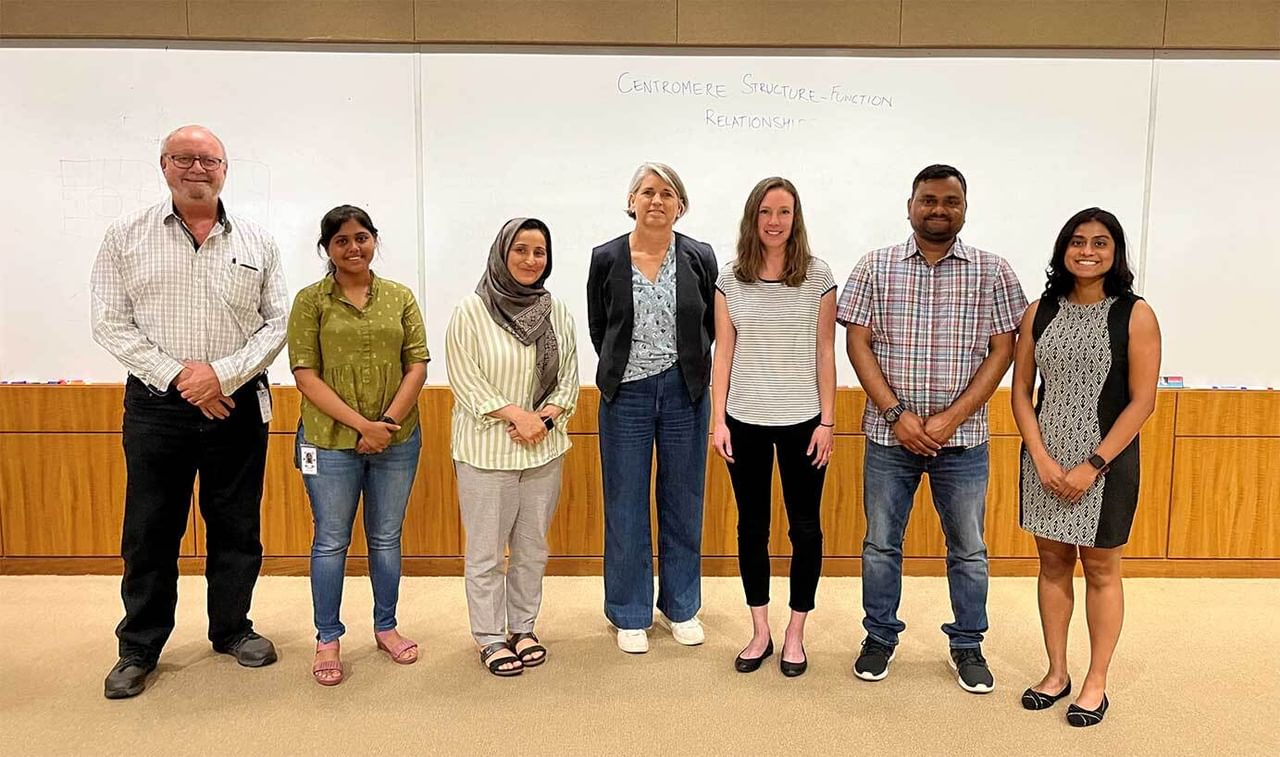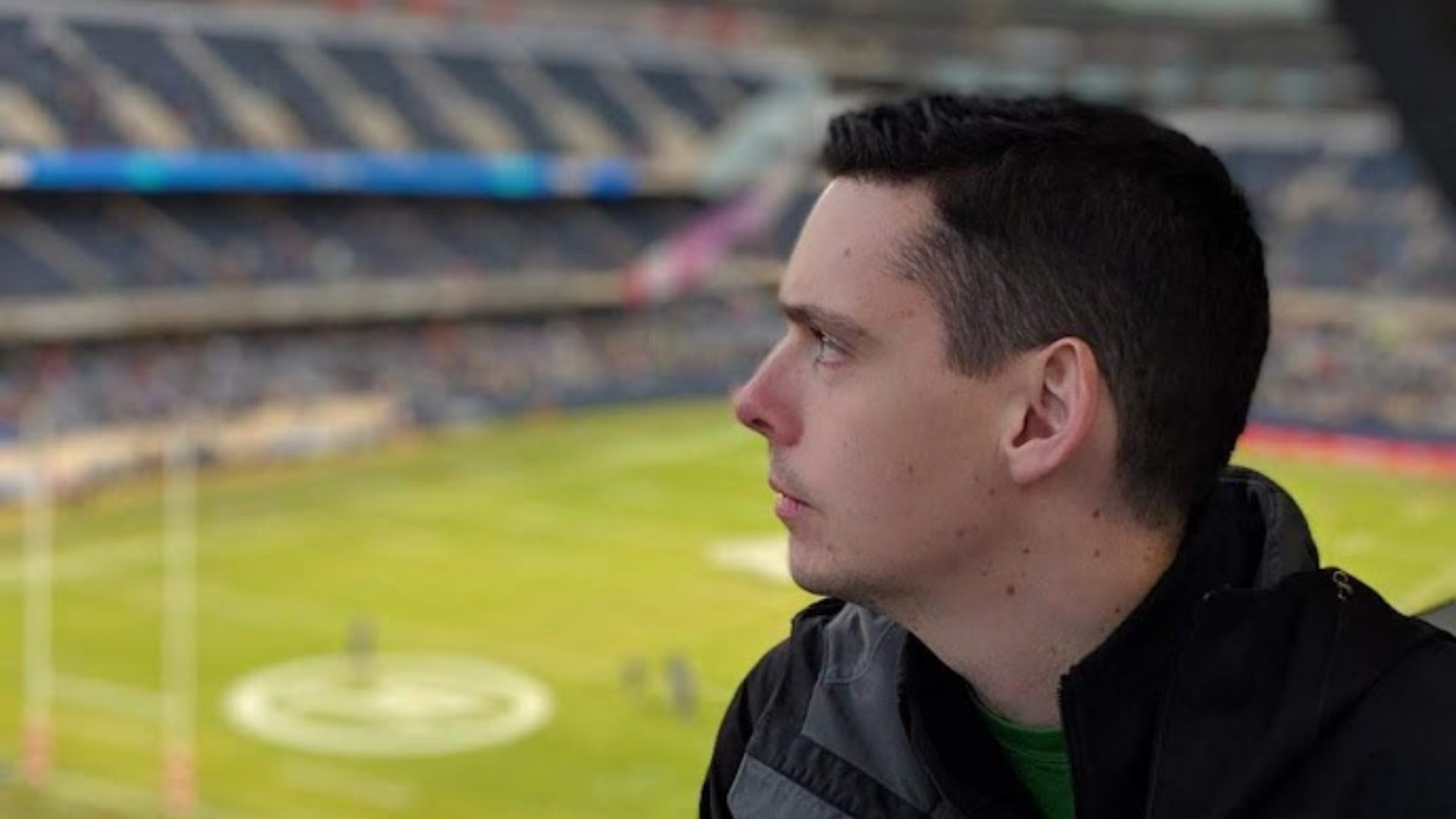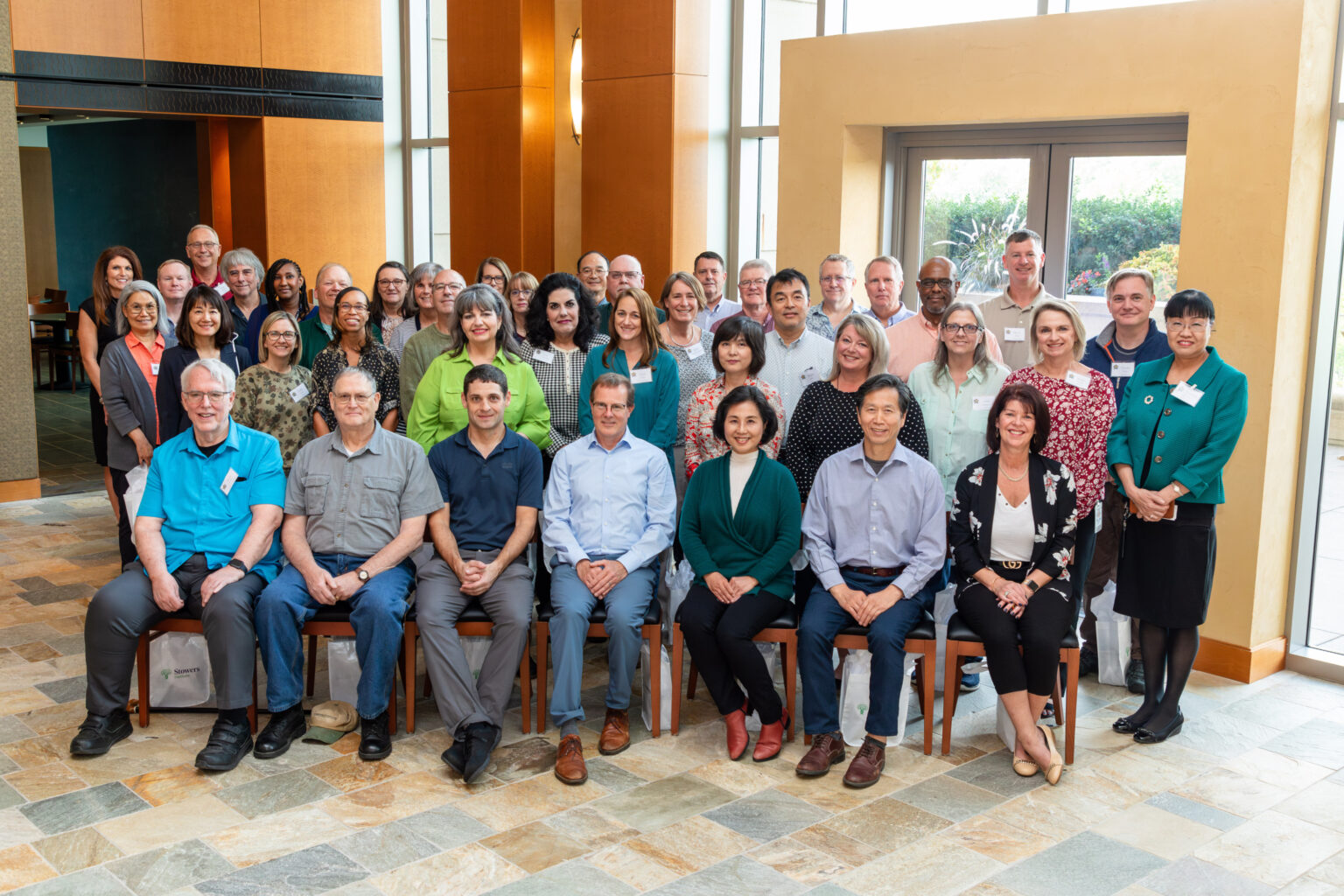News

24 June 2024
Stowers Faculty EDGE Workshop prepares postdocs for the academic job market
The Faculty EDGE series is just one of many advantages of the postdoctoral training program at the Stowers Institute.
Read Article
By Marla Vacek Broadfoot
Scott Hawley, PhD, was stumped. He had grappled with plenty of scientific problems over the course of his forty-year career, but this one was different. Hawley was hunting for a mutation that impairs a specific part of the biological machinery responsible for meiosis, the process that gives us eggs and sperm. His tried-and-true methods wouldn’t work. He scoured the literature, queried his colleagues, and even held impromptu meetings with his lab, to no avail.
Then one day Hawley embarked on the first in a series of lectures on the nature of mutation. As he stood in front of a classroom, bespectacled and likely donning one of his favorite argyle sweaters, he described how a single mistake in the three billion A’s, G’s, C’s, and T’s that make up the tendrils of our DNA can generate disease. Most diseases are recessive, he explained, meaning that they are caused by two copies of a particular mutation. But some diseases, he went on to say, are dominant, triggered by just one copy of a mutation. The moment the words left his mouth, Hawley realized what he needed to do. He had to stop looking for recessive mutations and start looking for dominant ones.
“It was one of the best genetic screens I had ever done,” says Hawley, Stowers investigator and founding dean of the Graduate School of the Stowers Institute. “We discovered a new mutation, and that spawned a number of high-profile papers and took my lab in a new direction. Some of the very best moments that I’ve ever experienced in my research career have come from lectures I’ve given, which force me to reexamine the basics of my craft.”
Other Stowers investigators can share similar stories of inspirational moments gained from teaching, but such moments could be thought of as just positive side effects of a training program well done. The main goal is to cultivate a lineage of expert minds who will answer their own questions and solve their own problems, in laboratories across the country and the world, for decades to come. That way, their impact won’t end with any single project or laboratory, but will grow larger over time. Like the ripples on a pond.
Inspiration
When Stowers Investigator Ron Yu, PhD, went to graduate school at Columbia University Medical Center over twenty-six years ago, he was surprised to learn that research was not the clocklike, precise endeavor portrayed in textbooks, but a sometimes messy, unpredictable process.
“I grew up in China, where it was common for educators to teach what was in the textbook as fixed knowledge. They didn’t teach students to question,” says Yu. “As soon as I started doing research, I realized I needed to question everything, whether it was my own data or a paper in a prestigious journal. Research can be chaotic and not as logical as one might imagine, but it is beautiful and fun because it tickles your mind. It demands as much creativity as solid reasoning.”
Today, Yu believes it is important to expose students to the reality of research early on, so they can decide for themselves if a career in science is right for them. He has hosted about fifty undergraduates in his laboratory, including many participants of the Stowers Summer Scholars Program, where students spend eight weeks conducting their own projects and attending scientific seminars. From their first day, Yu puts his students in the driver’s seat. He tells them to watch people work, ask questions, and figure out what interests them. They normally end up shadowing one of the senior researchers in the lab, assist with experiments over time, and eventually develop more independence.
“That’s my philosophy,” says Yu. “I think I carried it from my own mentors, who let me do almost anything of my own choosing. I found it rewarding, and it gave me the freedom to explore. I think that’s part of scientific discovery. Some of my students are coming up with things that I never thought about. I don’t want them to be restricted by the confines of my own understanding.”
Not everyone thrives under such conditions, but for those who do, it can solidify their path to an independent career. Yu has had many students return year after year, and many of his current graduate and predoctoral researchers are former Summer Scholars. In addition to researchers at different stages of training, Yu likes to keep a diverse mix of national and international lab members. “When people from different backgrounds interact, they complement and play off each other, and science in the lab is stronger for it.”
Training
Since the Stowers Institute for Medical Research opened its doors in 2000, about 400 undergraduate students, 230 graduate and predoctoral researchers, and 350 postdoctoral researchers have received research training in its labs. There are a variety programs and opportunities for pursuing an advanced degree at the Institute. Stowers investigators serve as mentors for the thesis projects of predoctoral researchers from three different graduate training programs, including those through the Institute’s affiliation with the University of Kansas Medical Center and the Open University, a public distance learning and research university based in the United Kingdom.

In the fall of 2011, the Institute launched its own graduate school with the vision of having an internal program for developing an elite cadre of young scientists. By design, the program is fast-paced and immersive. The first semester is a series of intensive two-week modules of lectures and lab work focused on specific topics like transcription or proteomics. Every module is run by a set of instructors who are experts in that topic. By the end, the predocs are not only up-to-date on the topics and techniques of the trade, but they have also gotten to know the Stowers faculty members and experts in cutting-edge technologies.
After predocs complete the course modules, they spend six months playing musical chairs, rotating through three different labs before finally deciding where they will spend the next three or four years conducting their thesis project. The Stowers Graduate School has attracted trainees from a dozen countries, and last December, predoc Kobe Yuen became the first to complete all requirements for the PhD degree. Yuen has moved on to a postdoctoral position at the biotech company Genentech in San Francisco.
Such postdoctoral positions can provide a valuable stepping stone for trainees as they move toward greater independence in their scientific pursuits, often with the goal of being ready to start a lab of their own or take a senior scientist position in private industry or government. Postdoctoral work typically lasts three to five years and gives trainees the opportunity to apply the scientific knowledge and skills they’ve learned to new areas of research. Over the years, the Stowers Institute has introduced numerous initiatives to support the postdocs among its ranks. Jerry Workman, PhD, a Stowers investigator and head of the Stowers postdoctoral affairs program, has led many of these efforts including a new faculty search group for postdocs who plan to apply for faculty positions, periodic workshops on applying for competitive grant funding, and expanded mentoring opportunities.
All of the Institute’s predocs and postdocs have the chance to benefit from the outstanding scientific support of Stowers core facilities and technology centers, which allows them to learn and apply different types of experimental approaches to advance their research ideas. In addition to training in research, with input from a group of predocs and postdocs the Institute runs Crossroads, a program focused on providing career advice, ideas, and new skill sets for all levels of trainees. There are also exceptional opportunities for scientific interaction, such as the annual Young Investigator Science Retreat sponsored by Crossroads.
Empowerment
Predoctoral Researcher Devika Salim joined the Institute two years ago after a short time in a graduate program at an Ivy League school. Investigator Jennifer Gerton, PhD, initially brought Salim on as a technician, but she suspected that Salim had a different path ahead of her. At their weekly meetings, Salim would surprise Gerton with bits of knowledge gleaned from the literature. Within a short time, Salim had developed a new droplet digital PCR assay that the lab could use to measure the amount of ribosomal DNA, a notoriously unstable form of genetic material. Shortly thereafter, Salim was generating mountains of data, starting her own thesis project, and working toward a PhD through the Institute’s affiliation with the Open University.

Salim credits the Molecular Biology Facility at the Institute with enabling her to accomplish so much so quickly. “It was nothing short of miraculous,” she says. More recently, she worked with the Cytometry Facility to develop a single-cell assay for quantifying the instability of ribosomal DNA in yeast.
At the Stowers Institute, researchers have access to the most cutting-edge, advanced technologies available, which Hawley says “teaches them to always work beyond their reach.” The Institute houses thirteen core facilities and technology centers run by a support staff of seventy trained scientists, covering practically every aspect of biomedical research from highly technical endeavors like mathematical modeling and electron microscopy to more routine tasks like media preparation and glass washing.
Impact
The scientific research culture at the Stowers Institute encourages not only those in formal training programs but also individuals at any stage of the career continuum to push themselves to the forefront of their field. Undergraduates have embarked upon graduate studies, predoctoral researchers have gone on to earn medical degrees or pursue postdoctoral work, and technicians have returned to school to become managers or leaders of core facilities.
Researchers of all stripes have the opportunity to present their work and get feedback from colleagues inside and outside the Institute through lab meetings, journal clubs, seminars, the Institute’s Friday Science Club, and scientific conferences. They can also attend career development events and other activities on campus. For example, the Crossroads group organizes professional and academic development days, which give trainees and others a chance to network with individuals from a variety of sectors such as academia, biotechnology and pharmaceuticals, venture capital, and scientific consulting.
Sue Jaspersen, PhD, a Stowers investigator who has trained more researchers than she can count, believes that a successful training program teaches young scientists that it isn’t all about them—that their job requires them to support the wider scientific community, to promote science and better society. “The only way to improve our chances of understanding a particular disease or improving health care or solving whatever problem we want to solve is through an intelligently trained workforce. I want to train people to think critically and work independently and look at data skeptically, and then be persuaded, as opposed to believing what they hear. Truth and data and facts matter, regardless of where you end up.”

A member of the first entering class of the Stowers Graduate School, Cori Cahoon, is beginning to think about what she will do once she finishes her PhD. The native Californian is leaning toward a postdoc in an academic lab on the West Coast, where she can keep doing basic research and carry on her mentor Scott Hawley’s legacy of teaching. Cahoon says one of her most rewarding experiences at Stowers has been training technicians and undergrads in the lab, particularly Nicole Nuckolls, who came to the lab as an undergraduate researcher. Cahoon taught her molecular biology and fruit fly genetics. Nuckolls then applied to and joined the Stowers Graduate School and is currently in Sarah Zanders’ lab, where she just submitted her first academic paper for publication.
At the Institute, the role of researchers is not only to generate knowledge but also to train the next generation how to tackle the scientific questions of tomorrow. That effort of preparing others for a lifetime of scientific pursuits can also reinvigorate one’s own research, generating fresh perspective when a different way of looking at things is needed.
“Science for me is like a puzzle, and it can be the most frustrating puzzle ever because you don’t have all the pieces out yet,” says Cahoon. “But when you are surrounded by younger scientists, it can energize you. There are moments when things just click—a real motivation to keep moving and keep reaching for the next level of understanding.”
News

24 June 2024
The Faculty EDGE series is just one of many advantages of the postdoctoral training program at the Stowers Institute.
Read Article
News

17 January 2024
Q&A with Stowers Postdoc Michael Church: “When I got the opportunity to join the Workman Lab, I jumped at the chance.”
Read Article
News

06 October 2023
Forty-nine members reached 20 years of service at the Stowers Institute. The Institute founders, Jim and Virginia Stowers, envisioned establishing the Institute as a long-term investment for advancing foundational knowledge in biology for the benefit of all.
Read Article